高中英语:2020届高考独立主格结构考点分析(浙江)
- 格式:doc
- 大小:51.00 KB
- 文档页数:10
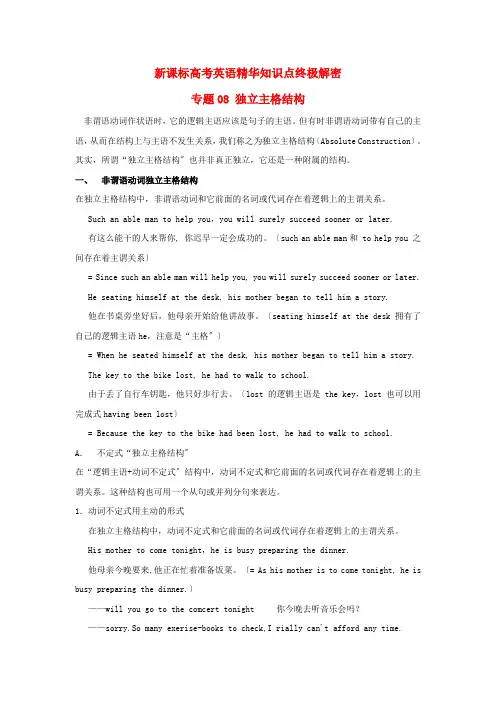
新课标高考英语精华知识点终极解密专题08 独立主格结构非谓语动词作状语时,它的逻辑主语应该是句子的主语。
但有时非谓语动词带有自己的主语,从而在结构上与主语不发生关系,我们称之为独立主格结构〔Absolute Construction〕。
其实,所谓“独立主格结构〞也并非真正独立,它还是一种附属的结构。
一、非谓语动词独立主格结构在独立主格结构中,非谓语动词和它前面的名词或代词存在着逻辑上的主谓关系。
Such an able man to help you,you will surely succeed sooner or later.有这么能干的人来帮你, 你迟早一定会成功的。
〔such an able man和 to help you 之间存在着主谓关系〕= Since such an able man will help you, you will surely succeed sooner or later. He seating himself at the desk, his mother began to tell him a story.他在书桌旁坐好后,他母亲开始给他讲故事。
〔seating himself at the desk拥有了自己的逻辑主语he,注意是“主格〞〕= When he seated himself at the desk, his mother began to tell him a story. The key to the bike lost, he had to walk to school.由于丢了自行车钥匙,他只好步行去。
〔lost 的逻辑主语是the key,lost 也可以用完成式having been lost〕= Because the key to the bike had been lost, he had to walk to school.A.不定式“独立主格结构〞在“逻辑主语+动词不定式〞结构中,动词不定式和它前面的名词或代词存在着逻辑上的主谓关系。
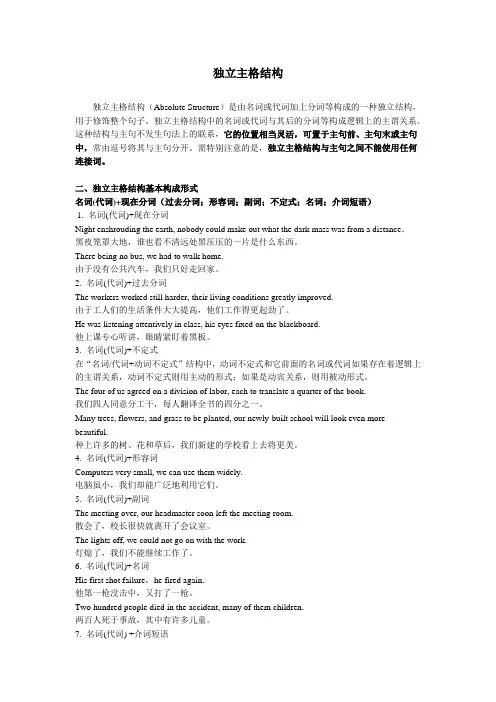
独立主格结构独立主格结构(Absolute Structure)是由名词或代词加上分词等构成的一种独立结构,用于修饰整个句子。
独立主格结构中的名词或代词与其后的分词等构成逻辑上的主谓关系。
这种结构与主句不发生句法上的联系,它的位置相当灵活,可置于主句前、主句末或主句中,常由逗号将其与主句分开。
需特别注意的是,独立主格结构与主句之间不能使用任何连接词。
二、独立主格结构基本构成形式名词(代词)+现在分词(过去分词;形容词;副词;不定式;名词;介词短语)1. 名词(代词)+现在分词Night enshrouding the earth, nobody could make out what the dark mass was from a distance.黑夜笼罩大地,谁也看不清远处黑压压的一片是什么东西。
There being no bus, we had to walk home.由于没有公共汽车,我们只好走回家。
2. 名词(代词)+过去分词The workers worked still harder, their living conditions greatly improved.由于工人们的生活条件大大提高,他们工作得更起劲了。
He was listening attentively in class, his eyes fixed on the blackboard.他上课专心听讲,眼睛紧盯着黑板。
3. 名词(代词)+不定式在“名词/代词+动词不定式”结构中,动词不定式和它前面的名词或代词如果存在着逻辑上的主谓关系,动词不定式则用主动的形式;如果是动宾关系,则用被动形式。
The four of us agreed on a division of labor, each to translate a quarter of the book.我们四人同意分工干,每人翻译全书的四分之一。
Many trees, flowers, and grass to be planted, our newly-built school will look even more beautiful.种上许多的树、花和草后,我们新建的学校看上去将更美。
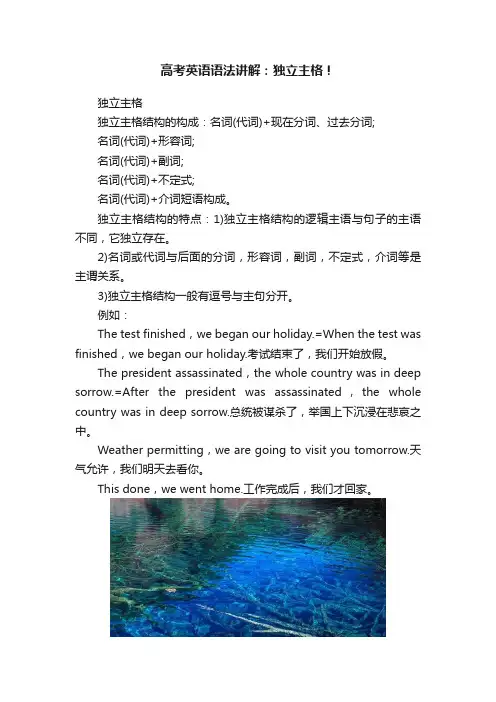
高考英语语法讲解:独立主格!独立主格独立主格结构的构成:名词(代词)+现在分词、过去分词;名词(代词)+形容词;名词(代词)+副词;名词(代词)+不定式;名词(代词)+介词短语构成。
独立主格结构的特点:1)独立主格结构的逻辑主语与句子的主语不同,它独立存在。
2)名词或代词与后面的分词,形容词,副词,不定式,介词等是主谓关系。
3)独立主格结构一般有逗号与主句分开。
例如:The test finished,we began our holiday.=When the test was finished,we began our holiday.考试结束了,我们开始放假。
The president assassinated,the whole country was in deep sorrow.=After the president was assassinated,the whole country was in deep sorrow.总统被谋杀了,举国上下沉浸在悲哀之中。
Weather permitting,we are going to visit you tomorrow.天气允许,我们明天去看你。
This done,we went home.工作完成后,我们才回家。
The meeting gone over,everyone tired to go home earlier.会议结束后,每个人都想早点回家。
He came into the room,his ears red with cold.他回到了房子里,耳朵冻得红通通的。
He came out of the library,a large book under his arm.他夹着本厚书,走出了图书馆10.2 with的复合结构作独立主格表示伴随情况时,既可用分词的独立结构,也可用with的复合结构:with+名词(代词)+现在分词/过去分词/形容词/副词/不定式/介词短语。
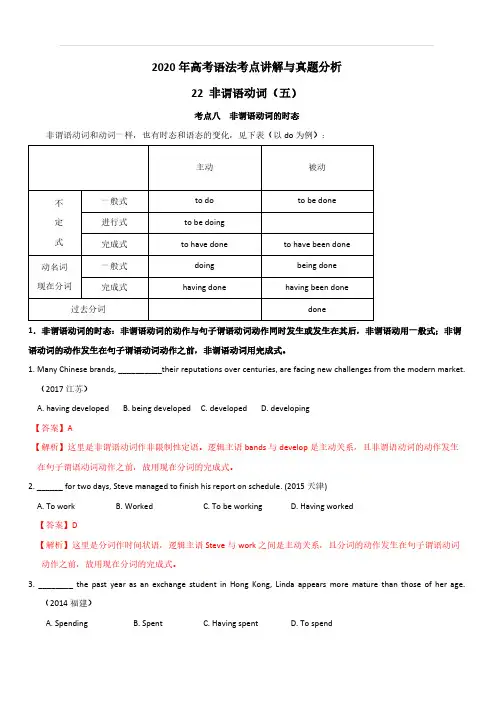
2020年高考语法考点讲解与真题分析22 非谓语动词(五)考点八 非谓语动词的时态非谓语动词和动词一样,也有时态和语态的变化,见下表(以do 为例):主动被动一般式to do to be done 进行式to be doing 不定式完成式to have done to have been done 一般式doing being done 动名词现在分词完成式having done having been done过去分词done 1.非谓语动词的时态:非谓语动词的动作与句子谓语动词动作同时发生或发生在其后,非谓语动用一般式;非谓语动词的动作发生在句子谓语动词动作之前,非谓语动词用完成式。
1. Many Chinese brands, __________their reputations over centuries, are facing new challenges from the modern market. (2017江苏)A. having developedB. being developedC. developedD. developing【答案】A【解析】这里是非谓语动词作非限制性定语。
逻辑主语bands 与develop 是主动关系,且非谓语动词的动作发生在句子谓语动词动作之前,故用现在分词的完成式。
2. ______ for two days, Steve managed to finish his report on schedule. (2015天津)A. To workB. WorkedC. To be workingD. Having worked【答案】D【解析】这里是分词作时间状语,逻辑主语Steve 与work 之间是主动关系,且分词的动作发生在句子谓语动词动作之前,故用现在分词的完成式。
3. ________ the past year as an exchange student in Hong Kong, Linda appears more mature than those of her age. (2014福建)A. SpendingB. SpentC. Having spentD. To spend【答案】C【解析】这里是分词作原因状语,逻辑主语Linda与spend之间是主动关系,且分词的动作发生在句子谓语动词动作之前,故用现在分词的完成式。
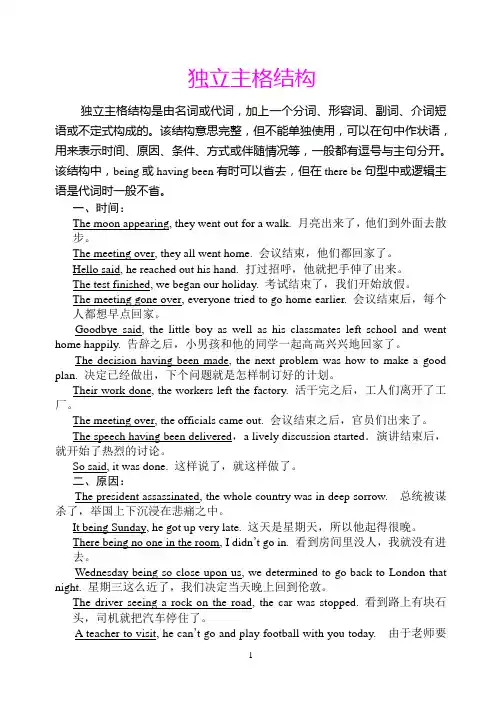
独立主格结构独立主格结构是由名词或代词,加上一个分词、形容词、副词、介词短语或不定式构成的。
该结构意思完整,但不能单独使用,可以在句中作状语,用来表示时间、原因、条件、方式或伴随情况等,一般都有逗号与主句分开。
该结构中,being或having been有时可以省去,但在there be句型中或逻辑主语是代词时一般不省。
一、时间:The moon appearing, they went out for a walk. 月亮出来了,他们到外面去散步。
The meeting over, they all went home. 会议结束,他们都回家了。
Hello said, he reached out his hand. 打过招呼,他就把手伸了出来。
The test finished, we began our holiday. 考试结束了,我们开始放假。
The meeting gone over, everyone tried to go home earlier. 会议结束后,每个人都想早点回家。
Goodbye said, the little boy as well as his classmates left school and went home happily. 告辞之后,小男孩和他的同学一起高高兴兴地回家了。
The decision having been made, the next problem was how to make a good plan. 决定已经做出,下个问题就是怎样制订好的计划。
Their work done, the workers left the factory. 活干完之后,工人们离开了工厂。
The meeting over, the officials came out. 会议结束之后,官员们出来了。
The speech having been delivered,a lively discussion started.演讲结束后,就开始了热烈的讨论。
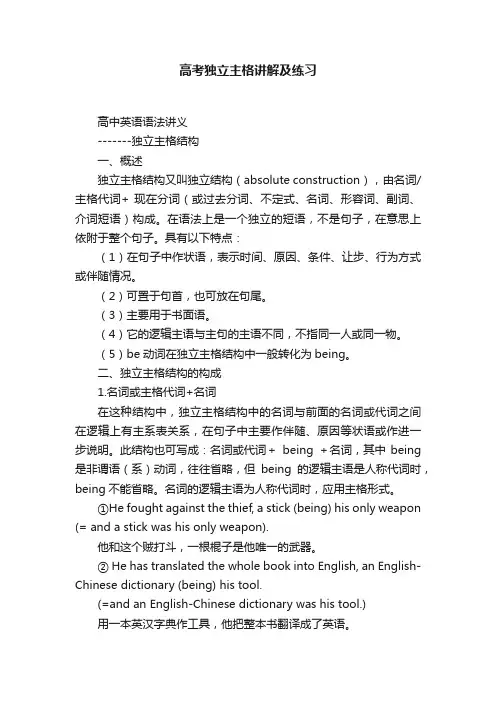
高考独立主格讲解及练习高中英语语法讲义-------独立主格结构一、概述独立主格结构又叫独立结构(absolute construction),由名词/主格代词+ 现在分词(或过去分词、不定式、名词、形容词、副词、介词短语)构成。
在语法上是一个独立的短语,不是句子,在意思上依附于整个句子。
具有以下特点:(1)在句子中作状语,表示时间、原因、条件、让步、行为方式或伴随情况。
(2)可置于句首,也可放在句尾。
(3)主要用于书面语。
(4)它的逻辑主语与主句的主语不同,不指同一人或同一物。
(5)be动词在独立主格结构中一般转化为being。
二、独立主格结构的构成1.名词或主格代词+名词在这种结构中,独立主格结构中的名词与前面的名词或代词之间在逻辑上有主系表关系,在句子中主要作伴随、原因等状语或作进一步说明。
此结构也可写成:名词或代词+being +名词,其中being 是非谓语(系)动词,往往省略,但being的逻辑主语是人称代词时,being不能省略。
名词的逻辑主语为人称代词时,应用主格形式。
①He fought against the thief, a stick (being) his only weapon (= and a stick was his only weapon).他和这个贼打斗,一根棍子是他唯一的武器。
② He has translated the whole book into English, an English-Chinese dictionary (being) his tool.(=and an English-Chinese dictionary was his tool.)用一本英汉字典作工具,他把整本书翻译成了英语。
③It being Sunday (=As it was Sunday), I didn’t go to school.(句中的being不能省略)因为是星期天,我没有上课。
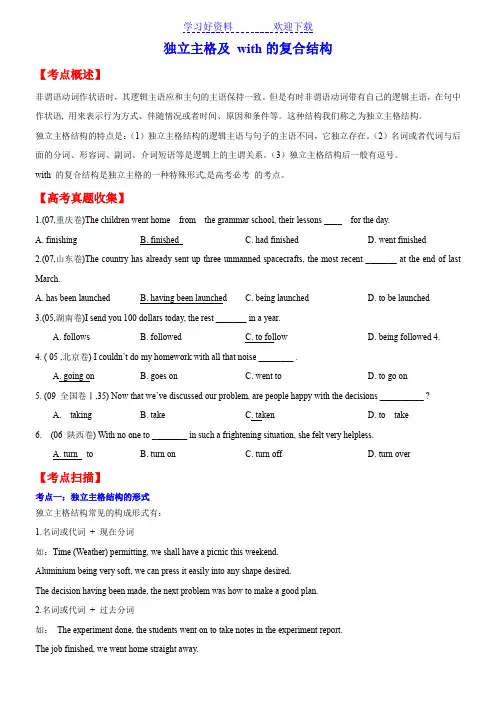
独立主格及with的复合结构【考点概述】非谓语动词作状语时,其逻辑主语应和主句的主语保持一致。
但是有时非谓语动词带有自己的逻辑主语,在句中作状语, 用来表示行为方式、伴随情况或者时间、原因和条件等。
这种结构我们称之为独立主格结构。
独立主格结构的特点是:(1)独立主格结构的逻辑主语与句子的主语不同,它独立存在。
(2)名词或者代词与后面的分词、形容词、副词、介词短语等是逻辑上的主谓关系。
(3)独立主格结构后一般有逗号。
with 的复合结构是独立主格的一种特殊形式,是高考必考的考点。
【高考真题收集】1.(07,重庆卷)The children went home from the grammar school, their lessons ____ for the day.A. finishingB. finishedC. had finishedD. went finished2.(07,山东卷)The country has already sent up three unmanned spacecrafts, the most recent _______ at the end of last March.A. has been launchedB. having been launchedC. being launchedD. to be launched3.(05,湖南卷)I send you 100 dollars today, the rest _______ in a year.A. followsB. followedC. to followD. being followed 4.4. ( 05 ,北京卷) I couldn’t do my homework with all that noise ________ .A. going onB. goes onC. went toD. to go on5. (09 全国卷Ⅰ,35) Now that we’ve discussed our problem, are people happy with the decisions __________ ?A. takingB. takeC. takenD. to take6. (06 陕西卷) With no one to ________ in such a frightening situation, she felt very helpless.A. turn toB. turn onC. turn offD. turn over【考点扫描】考点一:独立主格结构的形式独立主格结构常见的构成形式有:1.名词或代词+ 现在分词如:Time (Weather) permitting, we shall have a picnic this weekend.Aluminium being very soft, we can press it easily into any shape desired.The decision having been made, the next problem was how to make a good plan.2.名词或代词+ 过去分词如:The experiment done, the students went on to take notes in the experiment report.The job finished, we went home straight away.The sum added, we’ll have enough money for the trip.注意:用现在分词还是过去分词,要看前面的名词或代词与后面动词的关系。
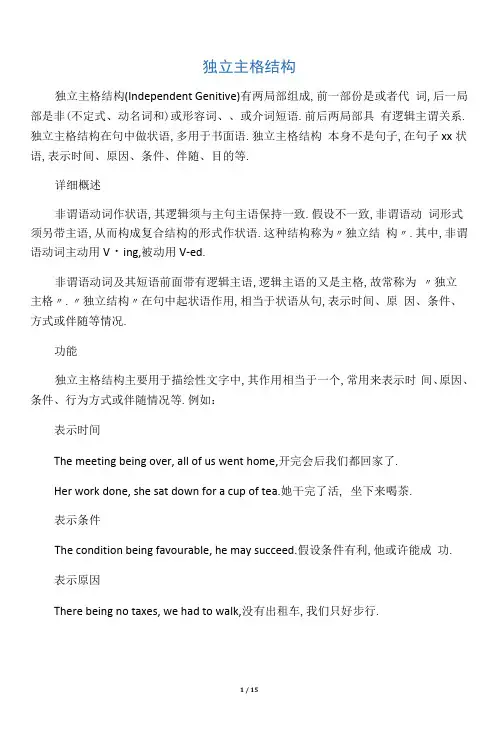
独立主格结构独立主格结构(Independent Genitive)有两局部组成,前一部份是或者代词,后一局部是非(不定式、动名词和)或形容词、、或介词短语.前后两局部具有逻辑主谓关系.独立主格结构在句中做状语,多用于书面语.独立主格结构本身不是句子,在句子xx状语,表示时间、原因、条件、伴随、目的等.详细概述非谓语动词作状语,其逻辑须与主句主语保持一致.假设不一致,非谓语动词形式须另带主语,从而构成复合结构的形式作状语.这种结构称为〃独立结构〃.其中,非谓语动词主动用V・ing,被动用V-ed.非谓语动词及其短语前面带有逻辑主语,逻辑主语的又是主格,故常称为〃独立主格〃.〃独立结构〃在句中起状语作用,相当于状语从句,表示时间、原因、条件、方式或伴随等情况.功能独立主格结构主要用于描绘性文字中,其作用相当于一个,常用来表示时间、原因、条件、行为方式或伴随情况等.例如:表示时间The meeting being over, all of us went home,开完会后我们都回家了.Her work done, she sat down for a cup of tea.她干完了活, 坐下来喝茶.表示条件The condition being favourable, he may succeed.假设条件有利,他或许能成功.表示原因There being no taxes, we had to walk,没有出租车,我们只好步行.1 / 15He wrapped her up with great care, the night being dark and frosty. 夜又黑又冷,所以他把她裹得严严实实的.表示伴随情况Almost all metals are good conductors, silver being the best of all. 几乎所有的金属都是良导体,而银那么是最好的导体.(=Almost all metals are good conductors, and silver is the best of all.)用法独立主格结构主要表示发生的时间、原因、条件或伴随情况等,相当于一个状语从句或并列句.用作时间状语The work done(=After the work had been done), we went home. 1:作完成后, 我们就回家了.用作条件状语Weather permitting(=lf weather permits), they will go on an outing to the beach tomorrow.如果天气允许的话,他们将在明天组织一次xx小游.用作原因状语An important lecture to be given tomorrow(=As an important lecture will be given tomorrow), the professor has to stay up late into the night. 由于明天要发表一个重要的演讲,教授不得不熬夜到很晚.用作伴随状语He was lying on the grass,his hands crossed under his head(=and his hands were crossed under his head),他躺在草地上,两手交叉枕在脑后.表示补充说明2/15We redoubled our efforts, each man working like two.我们加倍努力,一个人干两个人的活.*注:独立主格结构表示时间、条件或原因时,相当于一个状语从句,一般放在句首,表示原因时还可放在句末;表伴随状况或补充说明时,相当于一个并列句,通常放于句末.形式1> 一般独立主格形式:与主句逻辑关系松散形式为:n. + -ed/-ing形式;n. +不定式;n. +; n. + ; n. +副词.;名词/主格代词+现在分词名词/主格代词与之间是主谓关系.如:The girl staring at him(= As the girl stared at him), he didn't know what to say. 姑娘两眼望着他,他不知道说什么好.Time permitting(= If time permits), we will go for an outing tomorrow. 如果时间允许的话,我们明天去郊游.名词/主格代词+过去分词名词/主格代词与过去分词之间是动宾关系.如:The problems solved(= As the problems were solved), the quality has been improved.随着问题的解决,质量已经提升了.Her glasses broken(= Because her glasses were broken), she couldn't see the words on the blackboard,由于眼镜摔坏了,她看不见黑板上的字.名词/主格代词+不定式名词/主格代词与不定式之间是主谓关系,且强调的是一次具体性的动作. 如:3/15He is going to make a model plane, some old parts to help. 借助于一些I日零件,他要做一个飞机模型.They said good-bye to each other, one to go home, the other to go to the bookstore.他们道别后,一个回了家,一个去了书店.名词/主格代词+形容词如:An air accident happened to the plane,nobody alive.那架飞机遭遇了空难,无一人生还.So many people absent, the meeting had to be called off,这么多人缺席,会议不得不取消.名词/主格代词+副词如:He put on his sweater,wrong side out,他把毛衣穿反了.The meeting over, they all went home.会议一结束,他们就都回家了.名词/主格代词+介词短语如:The boy goes to the classroom,book in hand,那男孩手里拿着书去教室.Mary was sitting near the fire, her back towards the door.靠近火炉坐着,背对着门.2>with引导的独立主格:与主句逻辑关系紧密形式为:with + n. + -ed/-ing 形式;with + n. +abj.; with +n. + 介词短语3>each引导的强调型独立主格:尾的复数名词4/15形式为:句子+复数名词结尾,each +介词短语/形容词短语/名词短语/・ing 形式/-ed形式如:4>其他形式There being +名词〔代词〕如:There being nothing else to do, we went home.没有别的事可做,我们就回家了.There being no further business, I declare the meeting closed. 没有再要讨论的事了,我宣布散会.It being +名词〔代词〕如:It being Christmas, the government offices were closed. 由于圣诞节的缘故, 政府机关都休息.It being a holiday, all the shops were shut,由于今天是,所有商店都关门了.特点1〕独立主格结构的与句子的主语不同,它独立存在.2〕名词或代词与后面的,形容词,副词,不定式,等是主谓关系.3〕独立主格结构一般有逗号与主句分开.举例:The test finished, we began our holiday.=When the test was finished, we began our holiday.5/15测试结束了,我们开始放假.The president assassinated, the whole country was in deep sorrow.=After the president was assassinated, the whole country was in deep sorrow.总统被谋杀了,举国上下沉浸在悲哀之中.Weather permitting, we are going to visit you tomorrow.如果天气允许,我们明天去看你.This done, we went home.工作完成后,我们才回家.The meeting gone over, everyone tired to go home earlier.会议结束后,每个人都想早点回家.He came into the room,his ears red with cold.他回到了房子里,耳朵冻坏了.He came out of the library, a large book under his arm.他夹着本厚书,走出了图书馆注:独立主格结构有时可在其前加上介词with.如:Don't sleep with the windows open.别开着窗睡觉.He was lying on the bed with all his clothes on.他和衣躺在床上.She came in with a book in her hand,她手里拿着一本书走了进来.He fell asleep with the lamp burning.他没熄灯就睡着了.I won't be able to go on holiday with my mother being il 由于妈妈有病,我无法去度假.6/15He sat there with his eyes dosed,他闭目坐在那儿.All the afternoon he worked with the door locked.整个下午他都锁着门在房里工作.I can't go out with all these clothes to wash.要洗这些衣服,我无法出去了.考前须知1•独立主格与状语从句的转换当状语从句的主语与主句的主语不是指同一个对象时,可用独立主格结构取代状语从句,但不再保存连词.如:After class was over (=Class being over / Class over), the students soon left the classroom.卜课后,学生很快离开了课室.2.不能省略being (having been)的情形:在以下两种情况下,独立主格结构中的being (或having been)不能省略.(1)独立主格的逻辑主语是代词时.如:It being Sunday, we went to church. 由于是星期天,我们去了做礼拜.(2)在There being+名词的结构中.如:There being no bus, we had to go home on foot.由于没有公共汽车,所以我们不得不步行回家.3.在〃名词(或代词)+介词短语〃构成的独立主格结构中,一般不用和冠词.如:Miss Smith entered the classroom, book in hand.xx 走进了课室,手里拿着一本书.比拟with 的复合结构.如:Miss Smith entered the classroom, with a book in her hand.4.独立主格结构没有所有格形式The chief-editor arriving, we began the meeting.主编来了,我们开始开会.(比拟复合结构.)例如请看下面一道题:Not far from the school there was a garden,owner seated in it playing chess with his little grandson every afternoon.7 / 15A. itsB. whoseC. whichD. that【分析】此题很容易误选B,许多同学会认为句中逗号后是一个非限制性的,whose在定语从句中用作定语修饰其后的名词owner.此分析从外表上看,似乎天衣无缝,但实质上是错的,原因是空格后根本不是一个句子,由于没有谓语.尽管句中有两个动词,但它们都是非谓语动词.也许有的同学认为,其中的seated可视为谓语动词,但是注意,seat用作动词时,它总是及物的,其后要么接,要么它就用于,所以假设在seated前加上助动词is,那么可以选择B (当然假设将seated改为sitting,也应选择A).所以此题最正确答案选Ao请再看一个类似的例子:(1)He wrote a lot of novels, many of translated into foreignlanguages.A. itB. themC.whichD. that(2)He wrote a lot of novels, many of were translated into foreignlanguages.A. it B. them C. which D. that第⑴应选B,而不能选C,是由于句中的translated是过去分词(非谓语动词),假设选C,那么该从句无谓语;第⑵应选C,该句是典型的,由于该句修饰的是前面的novels,即指物,所以只能用which做of的宾语,故此题选C.再请看下面一例:(3)He wrote a lot of novels, and many of were translated intoforeign languages.A. itB. themC. whichD. that【分析】此题与上面的第⑵题不同,两句间多了一个并列连词and,说明这是一个并列句,故应选B,那么不能选C.请做做以下三题(答案均为B):8/15(1)There I met several people, two of being foreigners.〔独立主格结构〕A. whichB. themC. whomD. that(2)There I met several people, two of were foreigners.〔非限制性定语从句〕A. whichB. whomC. whoD. that(3)There I met several people, and two of were foreigners.〔两个句子〕A. whichB. themC. whomD. that英语句子结构一.简单句:英语句子看上去纷繁庞杂,但仔细观察不外乎五个根本句式. 这五个根本句式可以演变出多种复杂的英语句子.换言之,绝大多数英语句子都是由这五个根本句式生成的.这五个根本句式如下:S十V主谓结构S十V十P主系表结构S十V十.主谓XX结构S十V十.1十.2主谓xx结构S十V十.主谓xx结构说明:S=主语;V=谓语;P =表语;O=xx语;.1 =间接xx语;02 =直接xx语;C=xx语补足语五个根本句式详细解释如下:LS十V句式在此句式中,V是不及物动词,又叫自动词〔vi.例如:9/15He runs quickly.他跑得快.They listened carefully.他们听得很仔细.He suffered from cold and hunger.他挨冻受饿.China belongs to the third world country. xx 属于第三世界国家. The gas has given out.煤气用完了.My ink has run out.我的钢笔水用完了.S十V十P句式The story sounds interesting.这个故事听起来有趣.The desk feels hard.书桌摸起来很硬.The cake tastes nice.饼尝起来很香.The flowers smell sweet and nice. 花闻起来xx.You have grown taller than before.你长得比以前高了.He has suddenly fallen ill.他忽然病倒了.He stood quite still.他静静地站看.He could never turn traitor to his country.他永远不会背叛他的祖国.注意:有些动词同时也是及物动词,可构成SVO句式,例如:He looked me up and down.他上下打量我.He reached his hand to feel the elephant.他伸出手来摸象.They are tasting the fish.他,们在品尝鱼.They grow rice in their home town.他们在家乡种水稻.10 /15He's got a chair to sit on.他有椅子坐.Please turn the sentence into English. 请把这个句xx 英语.3.S十V十.句式在此句式中,V是及物动词(vt.),因此有宾语.例如:I saw a film yesterday.我昨天看了一部电影.Have you read the story?你读过这个故事吗?They found their home easily.他们很容易找到他们的家.They built a house last year.他们去年建了一所房子.They've put up a factory in the village.他们在村里建了一座工厂.They have taken good care of the children.这些孩子他们照看得很好.You should look after your children well.你应该好好照看你的孩子.4.S十V十.1十02句式在此句式中,V是带有双宾语的及物动词.常见的须带双宾语的动词有give, ask, bring, offer, send, pay, lend, show, tell, buy, get; rob, warn 等.例如:He gave me a book/a book to me.他给我一本书.He brought me a pen/a pen to me.他带给我一枝钢笔.He offered me his seat/his seat to me.他把座位让给我.注意下边动词改写后介词的变化:Mother bought me a book/a book for me.妈妈给我买了一本书.He got me a chair/a chair for me.他给我弄了一把椅子.11 / 15Please do me a favor/a favor for me. 请帮我一下.He asked me a question/a question of me. 他问我个问题.注意,下边动词只有一种说法:They robbed the old man of his money.他们抢了老人的钱.He's warned me of the danger,他警告我注意危险.The doctor has cured him of his disease.医生治好了他的病.We must rid the house of the rats.我们必须赶走屋里的老鼠.They deprived him of his right to speak.他们剥夺了他说话的权利.5.S十V十.句式在此句式中,V是有宾语补足语的及物动词.常带宾语补足语的词有形容词、副词、介词短语、名词、不定式、现在分词、过去分词常见的可接宾语补足语的动词很多,哪些动词可接哪几种形式作宾补,须根据动词的惯用法而定,不能统而概论.请看下面的例子.They made the girl angry.他们使这个女孩生气了.They found her happy that day.他们发现那天她很快乐.I found him out.我发现他出去了.I saw him in.我见他在家.They saw a foot mark in the sand.他们发现沙地上有脚印.They named the boy Charlie.他们给这个男孩起名为查理.They felt the car moving fast.他们感到汽车行驶得很快.I heard the glass broken just now.我刚刚听到玻璃碎了.12 /15He found the doctor of study closed to him.他发现研究所的大门对他关闭了.英语的并列句一般情况下引不起巨大的阅读障碍,由于在分句之间往往有固定的连接词说明前后分句的关系.这样的连接词有以and为代表的表示意义延伸的并列连词、以.r为代表的表示选择概念的并列连词、以but为代表的表示转折的并列连词和表示原因的for四个类型.第一种包括and, not only ... but (also )..., neither ( nor).第二种包括or, either …or …;第三种包括but, while, whereas等.第四种只有一个for.对此我们分别举一个例句说明问题:(l)As is reported, a trade agreement was signed and a cultural exchange was arranged.(2)Not only is he himself interested in the subject but all his students are beginning to show an interest in it.(3)Dr. Fisher neither loves the environment, nor is he accustomed to the weather.(4)The children can go with us, or they can stay at home.(5)You can either go it by yourself, or you can ask someone else to do it.(6)The young man has often been praised, but he is never conceited.(7)While our country has plenty of oil, theirs has none.(8)They want to live in town, whereas we would rather live in the country.(9)They apparently have a good drainage system, for the streets never seem to flood after a downpour.有必要说明的是以上的关联词并非只能有一个含义,比方and就可以表示意义增补、动作先后、转折或让步、条件和结果等等一些用法.这里笔者只是提醒大家区分从句,所以这方面的语言知识请参考相关的语法书.13 / 15另外我们还应该把并列分句和并列结构(coordinate construction)区分开来. 并列结构是由并列连词或者其他并列手段例如标点符号连接起来的语法结构序列,它包括并列分句,也包括并列的词或者词组.3、附属句构成附属关系的复杂句包括名词性分句(Nominal Clauses)(可以作主语、宾语、同位语、主语补语)、关系分句(Relative Clauses)、状语分句(Adverbial Clauses) o对于它们的连接词,在相应的语法书上都不难找到,这里就不再多讲了.需要提醒读者的是,在判定句子的类型之后,最主要的工作就是分析简单句的成分,找到主句的谓语,真正抓住句子的纲领.下面请作练习二,首先识别多重分句的类型,然后找出主句和附属分句的谓语.Laboratory scientists accustomed to noticing subtle changes in the properties of substances they are investigating are doubtless better than you or I at certain sorts of observations.这里的主语是Laboratory scientists,但是后面跟了一个过去分词定语,其中分词中的介词又跟了一个-ing形式,-ing形式后又接了一个宾语和一个带有定语的状语.本句的谓语是are doubtless better than o4 •英语的信息末端原那么的应用在英语中,信息含量大的局部往往出现在句子的末尾.这个特点一方面造就了一些非正常语序的句子,另一方面可以给我们提供线索,帮助我们正确理解英语中的长句.我们知道,一个信息发出者要表达丰富的信息,离开从句是寸步难行的.可是不管句子结构多么复杂,根本的句型还是只有五种.下面我们可以通过逐一的分析,探讨英语难句形成的规律.对于SV结构,由于英语句子一般是末尾的信息含量大,所以这种句子往往难以构成阅读困难,至多是主语位置有定语从句或者同位语从句.例如:(例子).SVO 结构的难点在于主语和宾语都可以连接定语从句;SVC结构也难以构成较复杂的句子;SVOC结构如果出现长句,那么往往是补语被调整到宾语的前面;SV..结构也要注意哪个是直接宾语,哪个是间接宾语.14 / 15SVOC: People often let their fear of speaking up and appearing more dull- witted than their peers interfere with their understanding.Derived from theoretical considerations and confirmed by observations, the velocity-distance law has made secure the concept of an expanding universe.下面请做练习,识别主句的根本类型.1.They would find relevant the antislavery attitudes of Northerners during the colonial period, the conflict over slavery in the Constitutional Convention, the Missouri Compromise, the militant abolitionist movement of the 1830, and the Compromise of 1850.2.The study made clear that the working class that is so over-represented in crime statistics consists of lower-class people living in the lower-class areas of large cities.from the People's Daily on current affairs in .15 /15。
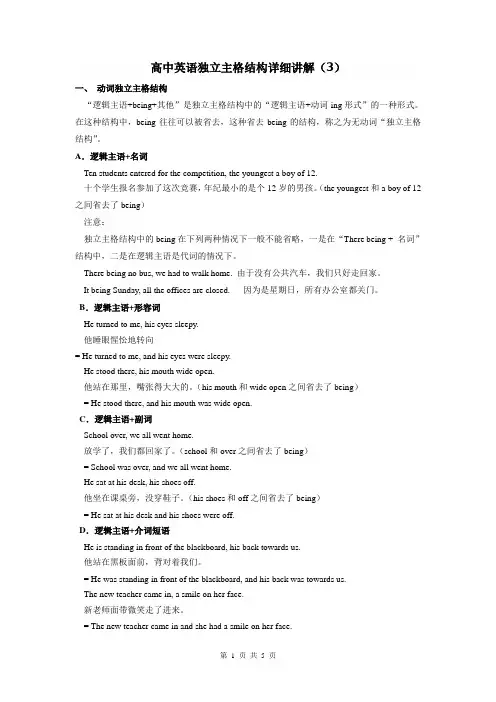
高中英语独立主格结构详细讲解(3)一、动词独立主格结构“逻辑主语+being+其他”是独立主格结构中的“逻辑主语+动词-ing形式”的一种形式。
在这种结构中,being往往可以被省去,这种省去being的结构,称之为无动词“独立主格结构”。
A.逻辑主语+名词Ten students entered for the competition, the youngest a boy of 12.十个学生报名参加了这次竞赛,年纪最小的是个12岁的男孩。
(the youngest和a boy of 12之间省去了being)注意:独立主格结构中的being在下列两种情况下一般不能省略,一是在“There being + 名词”结构中,二是在逻辑主语是代词的情况下。
There being no bus, we had to walk home. 由于没有公共汽车,我们只好走回家。
It being Sunday, all the offices are closed. 因为是星期日,所有办公室都关门。
B.逻辑主语+形容词He turned to me, his eyes sleepy.他睡眼惺忪地转向= He turned to me, and his eyes were sleepy.He stood there, his mouth wide open.他站在那里,嘴张得大大的。
(his mouth和wide open之间省去了being)= He stood there, and his mouth was wide open.C.逻辑主语+副词School over, we all went home.放学了,我们都回家了。
(school和over之间省去了being)= School was over, and we all went home.He sat at his desk, his shoes off.他坐在课桌旁,没穿鞋子。
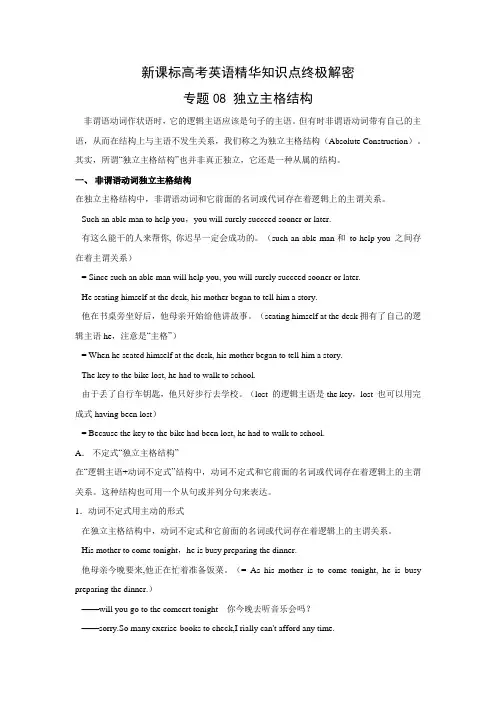
新课标高考英语精华知识点终极解密专题08 独立主格结构非谓语动词作状语时,它的逻辑主语应该是句子的主语。
但有时非谓语动词带有自己的主语,从而在结构上与主语不发生关系,我们称之为独立主格结构(Absolute Construction)。
其实,所谓“独立主格结构”也并非真正独立,它还是一种从属的结构。
一、非谓语动词独立主格结构在独立主格结构中,非谓语动词和它前面的名词或代词存在着逻辑上的主谓关系。
Such an able man to help you,you will surely succeed sooner or later.有这么能干的人来帮你, 你迟早一定会成功的。
(such an able man和to help you 之间存在着主谓关系)= Since such an able man will help you, you will surely succeed sooner or later.He seating himself at the desk, his mother began to tell him a story.他在书桌旁坐好后,他母亲开始给他讲故事。
(seating himself at the desk拥有了自己的逻辑主语he,注意是“主格”)= When he seated himself at the desk, his mother began to tell him a story.The key to the bike lost, he had to walk to school.由于丢了自行车钥匙,他只好步行去学校。
(lost 的逻辑主语是the key,lost 也可以用完成式having been lost)= Because the key to the bike had been lost, he had to walk to school.A.不定式“独立主格结构”在“逻辑主语+动词不定式”结构中,动词不定式和它前面的名词或代词存在着逻辑上的主谓关系。

高考:英语独立主格结构一、独立主格结构的概念独立主格结构(Absolute Structure)是由名词或代词加上分词等构成的一种独立结构,用于修饰整个句子。
独立主格结构中的名词或代词与其后的分词等构成逻辑上的主谓关系。
这种结构与主句不发生句法上的联系,它的位置相当灵活,可置于主句前、主句末或主句中,常由逗号将其与主句分开。
需特别注意的是,独立主格结构与主句之间不能使用任何连接词。
独立主格结构是一个名词或代词(作为逻辑主语),加上一个形容词、副词、介词短语、分词、不定式等在句中作状语。
它有以下三个特点:1. 独立主格结构的逻辑主语与句子的主语不同,它独立存在。
2. 名词或代词与后面的形容词、副词、介词短语、分词、不定式等存在逻辑上的主谓关系。
3. 独立主格结构一般用逗号与主句分开,但与主句之间不能使用任何连接词。
二、独立主格结构基本构成形式名词(代词)+现在分词(过去分词;形容词;副词;不定式;名词;介词短语)。
其中的“名词或代词”用主格形式,起逻辑主语的作用,其后的“形容词、副词、分词不、不定式等”起逻辑谓语的作用。
注意,独立主格结构与主句之间不能使用任何连接词。
1. 名词(代词)+现在分词Night enshrouding the earth, nobody could make out what the dark mass was from a distance.黑夜笼罩大地,谁也看不清远处黑压压的一片是什么东西。
There being no bus, we had to walk home.由于没有公共汽车,我们只好走回家。
2. 名词(代词)+过去分词The workers worked still harder, their living conditions greatly improved.由于工人们的生活条件大大提高,他们工作得更起劲了。
He was listening attentively in class, his eyes fixed on the blackboard.他上课专心听讲,眼睛紧盯着黑板。
独立主格结构:独立主格结构,又叫独立结构(absolute construction).它在句法上游离与句子主体之外,跟主句没有任何语法联系;但在意义上却与主句紧密联系在一起,给他构成一个完整的寓意环境。
独立主格结构没有主语和位于,只有逻辑上的主语,因此,它在句法上不是句子,而是一个独立于句子成分之外的独特结构形式。
独立主格结构可置于句首、句尾,用逗号上与主句隔开。
一、独立主格结构的形式独立结构可分为俩部分,一部分事名词或代词(主格),起着逻辑主语的作用;另一部分由形容词、副词、名词、分词、不定式、介词短语等构成,表示前面名词或代词的状态或动作。
1)名词/代词+形容词I heard that she got injured in the accident , my heart full of worry. 我听说她在这次事故中受了伤,内心充满担忧。
He stood silent in the moon-light, his door open .月光下,门开着,他默默地站在那。
2)名词/代词+现在分词Winter coming ,it gets colder and colder. 冬天来了,天气越来越冷了。
The rain having stopped ,he went out for a walk. 雨停了,他出去散散步。
3)名词/代词+过去分词More time given ,we should have done it much better. 如果给我们更多时间,我们会做的更好。
The boy stood there , his right hand raised. 那个男生站在那里,右手高举。
4)名词/代词(主格)+不定式Here are the first two volumes , the third one to come out next month.这是前俩卷,第三卷将于下雨问世。
高中英语独立主格结构用法总结独立主格结构独立主格结构是由一个相当于主语的名词或代词加上非谓语动词、形容词、副词或介词短语构成的一种独立主格成分。
With的复合结构可以看作是独立主格结构中的一种形式。
一、独立主格结构的特点1)独立主格结构的逻辑主语与句子的主语不同,它独立存在。
2)名词或代词与后面的分词,形容词,副词,不定式,介词等是主谓关系。
3)独立主格结构一般有逗号与主句分开。
The test finished, we began our holiday.= When the test was finished, we began our holiday.二、独立主格结构的构成:名词普通格或代词主格+ 现在分词/过去分词/不定式/名词/形容词/副词/介词短语。
1.名词(或代词)+ doing(doing表示前面的名词或代词主动进行的动作或状态)The guide leading the way, we had no trouble getting out of the forest.向导领着路,我们毫不费力地走出了森林。
He seating himself at the desk, his mother began to tell him a story.注意:系动词be也可以用分词形式的独立结构。
It being National Day today,the streets are very crowded.=As it is National Day today,the streets are very crowded.)There being no further business to discuss,we all went home.=As there was no further business to discuss,we all went home.)没有别的事可讨论,我们都回家了。
揭秘独立主格结构考点 独立主格结构,又叫做独立结构。在形式上,独立主格结构与主句没有任何关系,但是在意思上却与主句密切联系在一起,共同构筑成一个完整的语义环境。独立主格结构只有逻辑上的主语和谓语,没有真正的主语和谓语,所以在句法上,独立主格结构不是句子,而是一个独立于句子成分之外的特殊结构。 独立主格结构主要起状语作用,其功能相当于一个状语从句,多用来表示行为方式或伴随情况,有时也可以表示时间、原因、条件等;可放在句首、句尾,用逗号与主句隔开。例如: The experiment done, we went on to take notes in the experiment report. = After the experiment had been done, we went on to take notes in the experiment report. 做完实验后,我们继续在实验报告上做笔记。 Cell phones being very small, we can use them conveniently. = Because cell phones are very small, we can use them conveniently. 因为手机很小,我们使用起来很方便。 Almost all metals are good conductors, silver being the best of all. = Almost all metals are good conductors, and silver is the best of all. 几乎所有的金属都是良导体,而银则是最好的导体。 独立主格结构可分为四类:独立分词结构;独立不定式结构;独立无动词结构with复合结构。 一、独立分词结构 其构成是“名词或代词主格+分词”。 由于独立主格结构中的名词或代词主格是分词逻辑上的主语,因此,如果构成分词的动词与其逻辑主语之间是主谓关系,使用表示主动意义的现在分词。例如: Weather permitting (=If weather permits), they will go on an outing to the beach tomorrow. 如果天气允许的话,他们将在明天组织一次海滨小游。(permit是其逻辑主语weather主动发出的动作,故使用现在分词。) 如果构成分词的动词与其逻辑主语之间是动宾关系,则使用表示被动意义的过去分词。例如: The problems solved (= As the problems were solved), the quality has been improved. 随着问题的解决,质量已经提高了。(solve与其逻辑主语the problems含有逻辑上的动宾关系,故应使用过去分词。) 【考例】 The children went home from the grammar school, their lessons _______ for the day. (2020年重庆卷) A. finishing B. finished C. had finished D. were finished 【解析】B。考查独立分词结构。该题目中间含有逗号,并且前后都没有连词,说明既不是复合句,也不是并列句,而是一个含有独立主格结构的简单句。动词finish与其逻辑主语their lessons含有逻辑上的动宾关系,应使用过去分词。 独立分词结构在使用中还应注意以下两点: 1)在独立分词结构中,如果强调分词的动作发生在主句谓语动词之前,用现在分词的完成式表示。例如: All the students having handed in their papers, the two teachers went out of the classroom. 在所有学生交完试卷之后,两位老师走出了教室。 The whole room having been painted, we began to feel tired. 整个房间刷完油漆后,我们开始感到疲惫。 【考例】The country has already sent up three unmanned spacecraft, the most recent ______at the end of last March. (2020年山东卷) A. has been launched B. having been launched C. being launched D. to be launched 【解析】B。本题中的逗号是解题的关键。句中出现了逗号,而且前后没有连词,说明这既不是复合句,也不是并列句,而是一个含有独立主格结构的简单句。由句意可知,分词表示的动作发生在主句谓语动词之前,用现在分词的完成式表示。 2)“There being+名词或代词主格”是独立主格结构的一种特殊形式,在意义上表示存在,充当原因状语或条件状语,其中的being不能省略。例如: There being no rain, the farmers had to water their fields day and night. (=As there was no rain, the farmers had to water their fields day and night.) 因为没有下雨,农民们只得日日夜夜忙着浇地。 There being nothing interesting in the lecture, the listeners felt a bit sleepy. (=As there was nothing interesting in the lecture, the listeners felt a bit sleepy.)因为在演讲中没有什么令人感兴趣的东西,听众感到有点困倦。 二、独立不定式结构 独立分词结构表示的时间可以与主句谓语动词同时发生,也可以在其之前发生;而独立不定式结构的时间是发生在主句谓语动词之后或还未发生。其构成是“名词或代词主格+不定式”。 在独立不定式结构中,如果“名词或代词主格”是“不定式”动作的发出者,则二者在逻辑上含有主谓关系,用不定式的主动形式。例如: Nobody to help us tomorrow, we can’t finish our task ahead of time. 如果明天没有人来帮忙,我们不可能提前完成任务。(help这一动作与其逻辑主语nobody有逻辑上的主谓关系,故使用不定式的主动形式。) 【考例】I send you 100 dollars today, the rest _____ in a year.(2020年湖南卷) A. follows B. followed C. to follow D. being followed 【解析】C。考查独立不定式结构。该题目中间含有逗号,并且前后都没有连词,说明这既不是复合句,也不是并列句,而是一个含有独立主格结构的简单句。根据句意,剩余的钱一年内给付,而且follow这一动作与the rest含有逻辑上的主谓关系,并且该动作尚未发生,故用“逻辑主语+不定式”构成独立主格结构。 如果“名词或代词主格”是“不定式”动作的承受者,则二者在逻辑上含有动宾关系,用不定式的被动式。例如: More presents to be given, she will find it difficult to accept. 再给她一些礼物,她就会觉得很难接受。(give这一动作与其逻辑主语more presents有逻辑上的动宾关系,故使用不定式的被动形式。) 三、独立无动词结构 其构成是“名词或代词主格+非谓语部分”。非谓语部分由名词及其短语、形容词、副词、介词短语充当。该结构用来表达对主句的补充说明、对主句动词意义上的伴随及事件发生的原因等。如果非谓语部分变成谓语动词,则可能构成非限制性定语从句,在实际运用中要区别开来。例如: He has visited many countries, most of them in Europe.他去过很多国家,多数是欧洲的。(如果在in Europe前面加上are,则变为非限制性定语从句,此时most of them中的them应改为关系代词which。) The visiting president has some friends in China, all of them young fellows.这位来访的总统在中国有几个朋友,他们都是年轻人。(如果在young fellows前面加上are,则变为非限制性定语从句,此时all of them中的them应改为关系代词whom。) She left the house in a hurry, only one window open.她匆匆忙忙离开家,有一扇窗户开着。 【考例】The growing speed of a plant is influenced by a number of factors, _____ are beyond our control.(2020年湖南卷) A. most of them B. most of which C. most of what D. most of that 【解析】B。本题考查“介词+关系代词”引导的非限制性定语从句。由于逗号之后是一个完整的句子,先行词factors在定语从句中作most of的宾语,故用关系代词which代替factors,并且引导定语从句。如果此题中后面部分去掉are,则选用A项,构成独立主格结构。 当非谓语部分是由介词in连接时,其前后的两个名词要么不加任何成分,要么同时加上冠词和物主代词。例如: The solider stood in front of the gate, (a) gun in (his) hand.士兵站